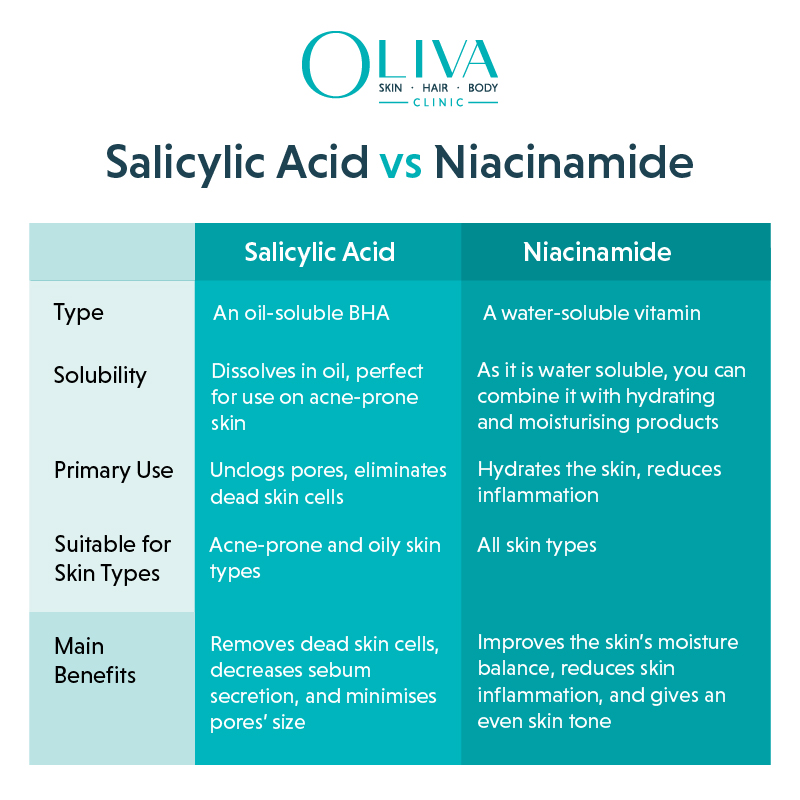Salicylic Acid vs Niacinamide: The Ultimate Guide to Clear and Healthy Skin
Healthy, glowing skin takes time and effort and two ingredients help in the process: Salicylic Acid and Niacinamide. These dermatologist-recommended ingredients, believed to be powerhouse products have several benefits to offer. In this article, learn in detail about how these ingredients work, their individual and combined benefits, and how best they can be used to improve skin health.
Table Of Content

What Is Salicylic Acid?
Salicylic Acid is one of the beta hydroxy acids (BHA) extracted from willow bark. Its pore-penetrating ability works as a skin exfoliant and helps reduce acne. It also minimises the appearance of pores by dissolving the intercellular connections of corneocytes. It is particularly helpful for pimples and other forms of skin inflammation, because it is oil soluble. [1]
Salicylic Acid also makes the skin’s keratin less rigid and more flexible, delicately rubbing off the uppermost layer of the skin and cleansing the pores. This reduces the chances of whiteheads, blackheads, and any other form of acne making the skin healthier.
Benefits of Salicylic Acid
Salicylic Acid is quite versatile and here are the benefits:
-
Exfoliation:
Eliminating the build-up of dead skin cells and improving their turnover.
-
Acne Reduction:
Removes clogging debris that cause acne and irritation on the skin. [2]
-
Oil Control:
Reduces sebum secretion making it ideal for oily skin.
-
Anti-inflammatory:
Helps get rid of redness and inflammation that may accompany acne and other skin concerns.
-
Improved Texture:
Reduces pore size, crow’s feet and other fine lines making the skin smoother.
What Is Niacinamide?
Niacinamide, also known as vitamin B3, is a gentle skin care ingredient well-loved for its multipurpose nature. It strengthens the skin barrier, by improving hydration and reducing inflammation. It is also suitable for all skin types.
It helps in the formation of ceramides – a type of fat that make up the skin’s armour. It improves the skin’s capacity to lock in moisture and protect it from aggravation by the environment. It also has antioxidant properties and it works to eliminate free radicals which are compounds that may cause harm to the skin and lead to early ageing. [3]
Benefits of Niacinamide
-
Hydration:
Reduces water loss, prevents skin dryness and helps the skin barrier by retaining moisture.
-
Anti-inflammatory:
Cools down sensitivity and relieves conditions such as dermatitis, eczema, and rosacea due to reduced inflammation and redness. [4]
-
Even Skin Tone:
Brightens the skin tone, thus reducing the signs of skin discolouration, including spots and uneven skin tone.
-
Pore Minimisation:
Makes the skin appear smoother by reducing pore size.
-
Anti-ageing:
Fades fine lines and wrinkles and increases elasticity, making skin appear younger.
Salicylic Acid vs Niacinamide
Understanding the differences between Salicylic Acid and Niacinamide can help you choose the right product for your skin concerns.
Here is a detailed comparison:
Feature |
Salicylic Acid |
Niacinamide |
| Type | Salicylic Acid is an oil-soluble BHA that can easily penetrate the skin’s lipid layers.
|
Niacinamide, on the other hand, is a water-soluble vitamin and you can apply it along with different types of skincare products.
|
| Solubility | Salicylic Acid dissolves in oil, making it perfect for removing dirt and oil that form a stubborn layer at the base of the hair follicle. This ingredient is also perfect for use on acne-prone skin. [5] | Since Niacinamide is water soluble, you can use it along with hydrating and moisturising products making for properly balanced skin care. |
| Primary Use | Commonly used as a skin exfoliant in acne treatment, salicylic acid unclogs the pores and eliminates dead skin cells contributing to acne. | Niacinamide hydrates the skin and reduces redness and inflammation. |
| Suitable for Skin Types | Salicylic acid is ideal for acne-prone and oily skin types. It helps regulate oil secretion and remove dead skin cells. | Niacinamide is healthy for all skin types because it soothes the skin and does not usually trigger reactions. |
| Main Benefits | Helps remove dead skin cells, decrease sebum secretion, and minimise the size of pores. | Improves moisture balance, reduces skin inflammation, and helps in achieving an even skin tone, making it suitable for all skin types. [6] |
| Common Products | Cleansers and spot treatments, to treat acne. | Moisturisers and serums to strengthen the protective barrier. |
| Frequency of Use | 2-3 times a week
|
You can use it daily due to its mild nature and as it blends with other skincare ingredients. |
| Combination with Other Ingredients | You can use it with other active ingredients such as retinoids and alpha hydroxy acids (AHAs). | It goes well with almost all ingredients. |
Combining Salicylic Acid and Niacinamide
When combined, Niacinamide and Salicylic Acid, offer plenty of benefits including reduced redness, pore clogging and inflammation. However, you should note that to avoid any skin irritation, [7] you should do include them in your skincare routine gradually.
Benefits:
- Enhanced Acne Treatment: The exfoliating ability of Salicylic Acid and the anti-inflammatory properties of Niacinamide can help reduce acne.
- Improved Skin Texture: The exfoliating property of salicylic acid, in combination with the moisturising and barrier repair properties of Niacinamide improves skin texture. [8]
- Balanced Oil Production: Salicylic Acid decreases excess oil on the surface of the skin and Niacinamide helps prevent drying.
- Reduced Redness and Inflammation: Niacinamide also minimises redness and inflammation, even that caused by Salicylic Acid. You can choose to stop using it based on how your skin reacts to it.
- Versatile Application: Salicylic Acid and Niacinamide are found in cleansers, moisturisers, and serums and can be easily incorporated into your skin care regimen.
How To Get the Best Results When Combining Salicylic Acid With Niacinamide?
To maximise the benefits of Salicylic Acid and Niacinamide, you can do the following:
-
Start Slowly:
Add one ingredient after the other into your skincare regimen and check your skin’s reaction to it. You can start with Niacinamide for a few weeks then add Salicylic Acid.
-
Layering:
Start with Niacinamide to calm the skin and then add Salicylic Acid. This layering order also helps prepare the skin for exfoliation while reducing any discomfort.
-
Moisturise:
Moisturise your skin before using Salicylic Acid to avoid dryness. Choose a moisturiser with ingredients such as hyaluronic acid or ceramides, which have a calming effect.
-
Sun Protection:
Always wear sunscreen as the exfoliating acids can make the skin more susceptible to UV radiation.
When To Use Salicylic Acid With Niacinamide?
It is best to use Salicylic Acid at night, while you can apply Niacinamide both in the morning and at night. If you have delicate skin, use the ingredients on different days as it helps reduce the chance of any skin reaction. [9]
Application Tips:
- Morning Routine: Cleanse your face first, then apply Niacinamide. Follow it up with a moisturiser and apply sunscreen as the final step.
- Evening Routine: Wash your face with a mild cleanser. Use Niacinamide serum first and follow it up with Salicylic Acid. Apply moisturiser as the final step.
Takeaway
Now you know that this duo of Salicylic Acid and Niacinamide will dramatically change your skincare game, making it look brighter and healthier. Make sure you incorporate them into your skincare regimen properly so you can target your skin concerns like inflammation, acne, or uneven skin tone and achieve healthier, more radiant skin. [10]
Frequently Asked Questions
Yes, you can apply Salicylic Acid and Niacinamide together.
Niacinamide and Salicylic Acid are best used based on individual skin concerns as they serve different purposes. Niacinamide hydrates the skin and reduces inflammation, while Salicylic Acid treats acne and exfoliates the skin.
Individuals with acne-prone or combination skin types can benefit from using Salicylic Acid and Niacinamide.
You can use Salicylic Acid 2-3 times a week and Niacinamide daily. If you are using them together, check your skin’s response and adjust usage accordingly.
Mixing Niacinamide and Salicylic Acid and using it as a single product is uncommon. You can layer them separately in your routine to make it safe and effective.
Use Niacinamide daily in the morning and evening. Use Salicylic Acid 2-3 times a week, in the evening, to exfoliate and treat acne.
Yes, using Salicylic Acid and Niacinamide together in the same skincare routine can address a variety of skin concerns, like oiliness, acne, and inflammation.
Salicylic Acid is more effective for treating acne as it penetrates pores and clears out oil and impurities.
First, Niacinamide is applied to calm the skin, followed by Salicylic Acid for acne treatment and exfoliation.
If you experience allergic reactions or irritation, avoid using Niacinamide.
Avoid mixing Niacinamide with ingredients containing high concentrations of pure vitamin C (ascorbic Acid) because they neutralise each other’s effectiveness.
Salicylic Acid should be limited to 2-3 times a week. Niacinamide, on the other hand, can be applied every night.
History







